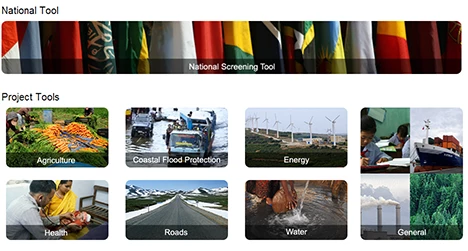From July 1, as part of the IDA-17 Replenishment all new operations funded by the International Development Association, IDA, the World Bank’s fund for the poorest countries, are to be screened for short and long-term climate and disaster risks (pdf) and, where risks exist, appropriate resilience measures are to be integrated.
Additionally, all IDA Country Partnership Frameworks are required to incorporate climate and disaster risk considerations into the analysis of a country’s development challenges and priorities and, when agreed with the country, incorporate such considerations into the content of the programs and the results framework.This is a major step forward in helping the poor and most vulnerable, those most at risk from climate change, prepare for the impacts of our rapidly warming world.
Bank staff can now access a new suite of online tools to help them identify potential risks to the projects and country plans they’re working on.
The new climate and disaster risk screening tools are exactly what they sound like: they provide due diligence at the early stages of project design to ensure that climate and disaster risks are flagged. Screening is a first, but essential, step to make sure that these risks are assessed and managed as we work on climate and disaster-resilient development.
It’s increasing clear that to end extreme poverty, we have to build resilient communities and mitigate shocks, like climate and natural disasters.
Over the last 30 years, the world has lost more than 2.5 million people and almost $4 trillion to natural disasters.
Economic losses are rising – from $50 billion each year in the 1980s, to just under $200 billion each year in the last decade. Three quarters of those losses are a result of extreme weather.
As more and more people move to cities built on flood plains and along coastlines in search of jobs and opportunities these trends will continue to rise. While all countries are impacted, developing nations bear the brunt of mounting losses in lives and livelihoods from increasingly severe floods, droughts, and storms.
Last year, a global coalition of developed and developing countries committed a record $52 billion for the replenishment of IDA.
The climate and disaster risk tools are aligned with, and provide contributions to, the new operations risk management approach being introduced at the Bank. They have benefited during the design, internal piloting and testing from the involvement of regional and thematic specialists across the Bank. Also, IFC is piloting a climate risk management process that will be used to identify and manage climate risks related to investments’ financial, environmental and social performance.
Consultation on the new screening tools has included outside stakeholders such as regional development banks and other development partners that are in the process of developing or deploying similar screening tools and resources.
Going forward, the tools will continue to be refined and enhanced to support risk assessment at the country level as new and improved data becomes available later over the coming year.
All of this will help us better predict and prepare for risk, allowing nations and communities to build the capacity they need to grow resilient, and to put in place response measures in a warming and more disruptive climate.
Update: The climate and disaster risk screen tools were released for public use in April 2015.



Join the Conversation